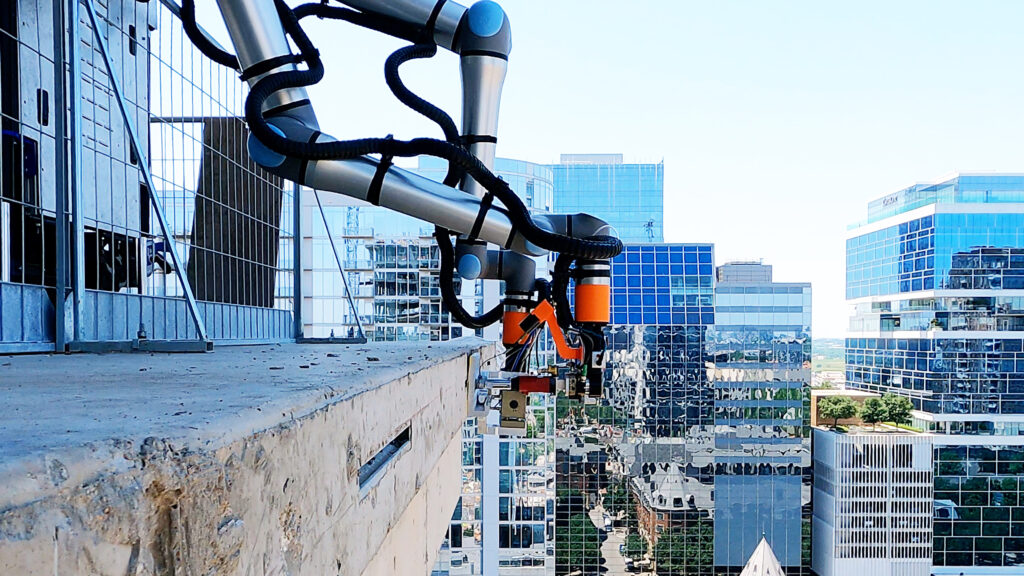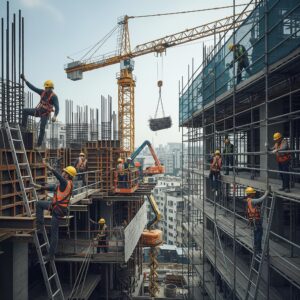
Every city skyline is defined by vertical construction. But building up brings unique efficiency and safety challenges due to confined sites, tight tolerances, and dozens of trades working in the same space. Robotics is helping many contractors find ways to improve speed and reduce risk on vertical construction projects.
In this article, we’ll explain what vertical construction is, how it differs from horizontal work, and demonstrate how robotics is reshaping the way teams work on these projects.
What is Vertical Construction?

Vertical construction refers to multi-story projects that grow upward from the ground, or below ground, rather than outward. Examples of vertical construction include skyscrapers, hospitals, hotels, parking garages, and multi-use buildings. These projects require precision and planning across multiple floors, as well as constant trade coordination, to ensure safety for those working above and below.
Maintaining the alignment of each floor requires exact stacking and measurement. A deviation of even an inch in the structure can cause visible façade misalignment or glass reflections that distort the building’s appearance.
Vertical Construction vs. Horizontal Construction
Horizontal construction refers to projects that cover a large area, such as roads, bridges, and pipelines. They often prioritize earthwork, grading, and linear alignment.
When compared to most horizontal construction projects, vertical builds require a higher level of trade coordination, especially when it comes to utilizing shared cranes and lifts, as well as more rigorous attention to alignment tolerances. Additionally, they have stricter safety requirements due to the limited staging and parking available on-site, as well as the dangers associated with overhead work.
How Robotics Solves the Biggest Challenges in Vertical Construction
The rise of robotics in vertical construction aligns with the industry’s broader goals of enhancing safety, speed, precision, and cost efficiency, particularly as cities shift toward denser, mixed-use developments and commercial-to-residential conversions.
According to research out of the Department of Civil and Environmental Engineering at Stanford University, robots increase productivity, quality, and safety in unstructured environments, such as construction, while lowering production costs. The researchers evaluated ten construction robots across 12 projects and found that robots reduced repetitive site work by 25-90%, improved accuracy by 55% on average, reduced rework by over 50%, and shortened project schedules by an average of 2.3 times.
Robotics can help contractors address many of the challenges associated with vertical projects, including safety risks, labor shortages, errors and rework, and rising costs. It can also help the wider industry achieve goals such as improving safety, speed, precision, and cost efficiency.
Robots can adapt to site complexities, operating safely around active trades, reacting to sensor inputs, and maintaining precise digital alignment between floors.
Safety Risks

Worker safety in vertical construction is a key concern. When working at height on small sites, workers are exposed to risks from falls, falling objects, fatigue, and congested work areas. Shared tower cranes, scaffolding, and lifts increase trade coordination demands across multiple floors and building sectors.
Robotic systems reduce exposure to these safety hazards by automating or assisting with tasks such as drilling, layout marking, inspections, or material handling. Modern field robots can navigate tight spaces and utilize real-time sensor feedback to avoid obstacles, including people, equipment, and materials, while maintaining operational safety.
Skilled Labor Shortage
The construction industry as a whole faces a significant labor gap, especially for the highly skilled and specialized trades needed for vertical projects. Finding adequately trained manpower for precision tasks, such as layout, curtain wall installation, or quality inspections, is becoming increasingly difficult.
Robotics can help alleviate the labor shortage in vertical construction by performing high-accuracy, repetitive tasks, reducing rework and allowing experienced workers to focus on higher-value activities, such as oversight, planning, and quality control. This results in a more stable and predictable workflow across trades and shifts, improving productivity and shortening schedules.
Construction Rework
Stacking floors precisely is one of the most challenging aspects of vertical construction. Structural concrete tolerances often allow up to ±1″ variation per level; yet, the façade must achieve consistent alignment within ±1/16″ so that the glass reflects a seamless mirror image rather than a distorted one.
Robotic layout and measurement systems help close this gap by ensuring every anchor, bracket, and frame point aligns with the digital model. This level of precision dramatically reduces rework, prevents costly cascading errors across floors, and improves the overall visual and structural quality of the structure. Also, less rework ensures schedule reliability and improves profitability for all involved.
Costs
Rising material and labor costs are key challenges in vertical construction, as they compound with the logistical challenges that are unique to vertical projects. Crews find themselves on standby while they wait for shared resources, such as cranes or lifts, to become available. Lack of staging space can also delay work, as contractors wait for materials to be delivered.
Robotics enhances efficiency and productivity by facilitating faster task completion, minimizing mistakes, rework, and downtime. Contractors can accelerate progress without increasing manpower. These gains compound as robots become capital assets that generate savings across multiple projects, ultimately paying for themselves.
How Raise Robotics Saved J.R. Butler $130K in Rework Costs on St. Jude Hospital Build

J.R. Butler, a glazing contractor, was hired to install 10,000 curtain wall panels on each of two 15-story hospital towers. Typically, a layout crew manually marks on the concrete where each panel would attach. By the time the crew began installing panels on the second floor, it became clear that the human crew lacked the precision required for the job. This resulted in $100,000 to $130,000 of rework and approximately six weeks of delay.
The team had used robots successfully before on other projects and decided to try them for this challenge, so they contacted Raise. The Raise solution delivered the precision required (1/16” tolerances) throughout the remaining floors, eliminated rework, and kept the project on schedule. All at a cost that was under the amount budgeted for layout. Read the full case study.
Robots and Vertical Construction
Vertical construction is evolving rapidly as cities grow denser and older commercial buildings are transformed into new residential and mixed-use spaces. This rapid growth increases risk to workers, schedules, and budgets. Robotics enables contractors to meet these demands safely, efficiently, and profitably, reducing risk while delivering precision that surpasses human capability.
By combining adaptive sensing, digital layout verification, and consistent performance, robots like those from Raise Robotics are setting a new benchmark for vertical construction excellence.
